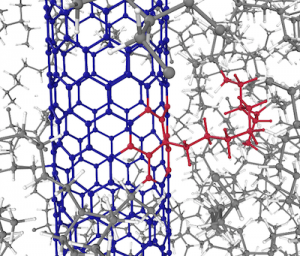J. R. Golebiowski, J. R. Kermode, P. D. Haynes and A. A. Mostofi, Atomistic QM/MM simulations of the strength of covalent interfaces in carbon nanotube-polymer composites, Phys. Chem. Chem. Phys. 22, 12007 (2020).
There is a “tyranny of scales” associated with the theoretical prediction of complex processes in materials and molecular systems. Often there is a small “active region” that governs the physics and chemistry of the phenomenon being investigated, but this region interacts and is influenced by the rest of the system, the “environment”, which is generally much larger and structurally more complex. Carbon nanotube-polymer composites are one such material. They are strong and lightweight with applications in demanding areas of industry such as ballistic protection and aerospace. Properties of the interface between carbon nanotubes (CNT) and polymers are a crucial factor affecting critical mechanical failure in these materials and chemical functionalisation of the CNTs can be used to promote strong interfaces based on CNT-polymer covalent crosslinks.
Developing a fundamental understanding of interfacial failure in CNT-polymer composites is challenging because the bond-breaking processes at the polymer-CNT attachment point that initiate failure are quantum-mechanical in nature, yet the mechanisms by which stresses are transferred through the disordered polymer occur on length-scales far in excess of anything that can be simulated quantum-mechanically.
In a paper appearing in Phys. Chem. Chem. Phys., we address the multi-scale nature of critical failure using a concurrent hybrid method that couples a quantum mechanical description of the bond-breaking process at the interface to a classical description of the remainder of the system. Using this “QM/MM” approach, which we first proposed and validated in an earlier work, we investigated the effects of different interfacial chemistries on mechanical strength and mechanisms mechanical failure in model CNT-polyethylene composites by simulating a CNT pull-out experiment. The predictions from our simulations can help to guide further experimental work with the aim of accelerating the design of high-performance CNT-polymer composites.
This work was part of Jacek Golebiowski’s PhD in the Centre for Doctoral Training in Theory and Simulation of Materials. Jacek was supervised by Peter Haynes, James Kermode and Arash Mostofi.
